The economy continued to downshift into the final quarter of last year. On a quarterly basis, real GDP growth eased further, slowing from 0.3 per cent in the September quarter 2023 to 0.2 per cent in the December quarter. On an annual basis, growth fell to just 1.5 per cent – the weakest outcome since the December quarter 2020. And in per capita terms, output fell over the quarter and over the year, further extending Australia’s ‘per capita’ recession as living standards once again went backwards. Indeed, the one per cent annual decline in GDP per capita last quarter was the steepest fall this century, outside the large drops associated with the pandemic in 2020.
Aggregate private sector domestic demand ended year the flat, with modest growth in overall activity driven by public spending and a positive contribution from net exports.
In large part, all this means the RBA’s efforts to tame inflation by squeezing the domestic economy remain broadly on track. In its latest forecasts, the central bank had predicted that annual GDP growth would end 2023 at 1.5 per cent, so this week’s outcome looks in line with Martin Place’s central scenario. And there were some encouraging signs of falling price pressures to be found in the data, along with a slight recovery in productivity (although developments in unit labour costs remain unhelpful). Seen from this perspective, the subdued level of activity is painful, but it is also the price of disinflation.
That said, the RBA has also consistently flagged uncertainties around the future path of household consumption as one key risk to the economic outlook. And here there were some indications that the chances of a downside scenario might have increased. In particular, the RBA had predicted household consumption growth of 0.4 per cent over the year for the December quarter. But the actual result turned out to be weaker, with growth running at just 0.1 per cent. Households are cutting back on discretionary spending as elevated debt service costs, the still high cost of living and a high tax take continue to compress disposable incomes.
The ongoing fall in living standards is also likely to be front of mind for the Treasurer as he considers this year’s budget choices. The reworking of the Stage 3 tax cuts is already scheduled to start to deliver some cost-of-living relief from mid-year. And the continuing fall in the inflation rate will also help. But unemployment is on its way up as the labour market weakens. So, the government will be thinking hard about how to balance demands for more fiscal support against the need to help the RBA stay on its narrow path. In the short term, macro policy for Australia’s fiscal and monetary authorities continues to require some delicate risk management.
More detail below.
Real GDP growth was just 0.2 per cent over December quarter 2023
The ABS published the latest set of National Accounts for the Australian economy this week, releasing GDP data for the December quarter 2023. According to the Bureau, real GDP growth eased to a seasonally adjusted 0.2 per cent quarter-on-quarter, down modestly from a (slightly upwardly revised) 0.3 per cent in the previous quarter. On an annual basis, growth slowed to 1.5 per cent from 2.1 per cent, delivering the lowest growth rate seen since the pandemic-hit final quarter of 2020. Set the pandemic aside, and this was the softest annual growth result since the final quarter of 2000.
Weak as it was, the December quarter outcome was in line with market consensus, which had expected 0.2 per cent quarterly and 1.5 per cent annual growth. It was also broadly in line with RBA’s forecast for 1.5 per cent year-on-year Q4:2023 real growth as presented in the February 2024 Statement on Monetary Policy.
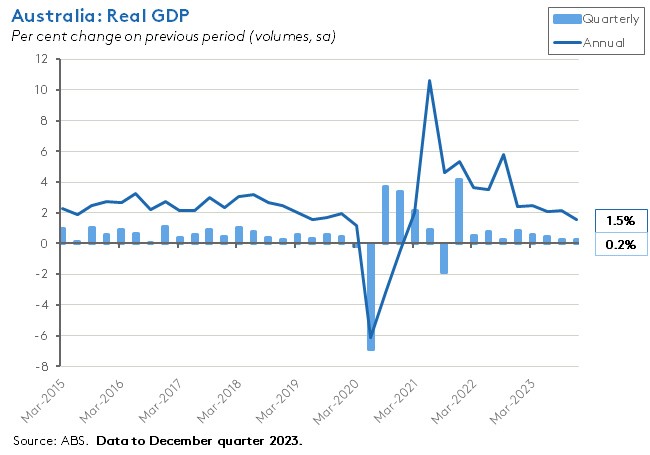
Although the real economy has now expanded for nine consecutive quarters, the pace of quarterly growth has been slowing consistently since the final quarter of 2022.
Weak household consumption growth drives stagnant private sector domestic demand
By expenditure item, real growth over the quarter was driven by government consumption (including government benefits for households such as higher Medicare and pharmaceutical benefits expenditure) and a positive contribution from net exports that reflected a larger decline in imports of goods and services relative to the drop in exports.
Overall, final public demand rose 0.4 per cent over the quarter and contributed about 0.1 percentage points to overall quarterly growth. But private final demand was flat in quarterly terms, adding nothing to GDP growth.
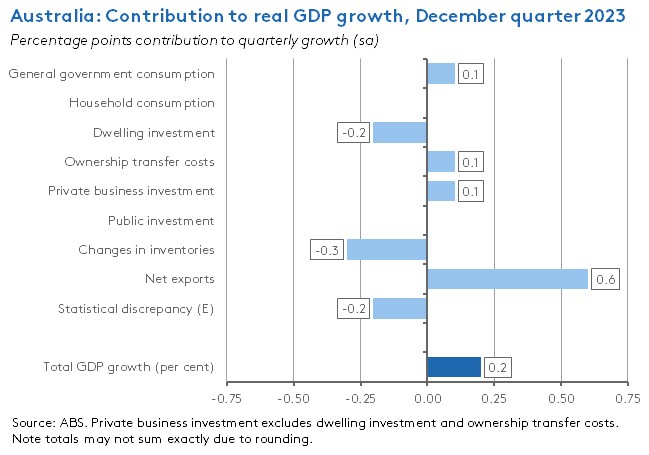
Total investment fell 0.2 per cent over the quarter, with both total public and private gross fixed capital formation declining by the same amount.
In the case of private investment, a quarterly increase of 0.7 per cent in business investment (which translated into a robust 8.2 per cent annual rise) was largely driven by a rise in non-dwelling construction related to spending on new warehouses and data centres. There was also an increase in investment in IP products. Together, these outweighed a fall in machinery and equipment investment, reflecting lower levels of spending on agricultural equipment. A rise in ownership transfer costs was another positive contributor to private sector gross capital formation. But these developments were offset by a sharp decline in dwelling investment. The latter fell 3.8 per cent over the quarter to be down 3.1 per cent over the year.
Risks to the Australian economic outlook in recent times have been particularly focused on the household sector, and there the December numbers showed household consumption up just 0.1 per cent over the quarter, with a 0.7 per cent increase in spending on essentials (food, electricity, gas, and other fuels) largely offset by a 0.9 per cent drop in discretionary spending on items such as hotels, cafes and restaurants, cigarettes and tobacco, new car purchases and clothing and footwear. Looking at a different cut of the data, household spending on goods rose 0.9 per cent quarter-on-quarter, while spending on services was down 0.4 per cent.
Consumption was also in weak in annual terms, again up just 0.1 per cent relative to the December quarter 2022. And household spending contracted in per capita terms.
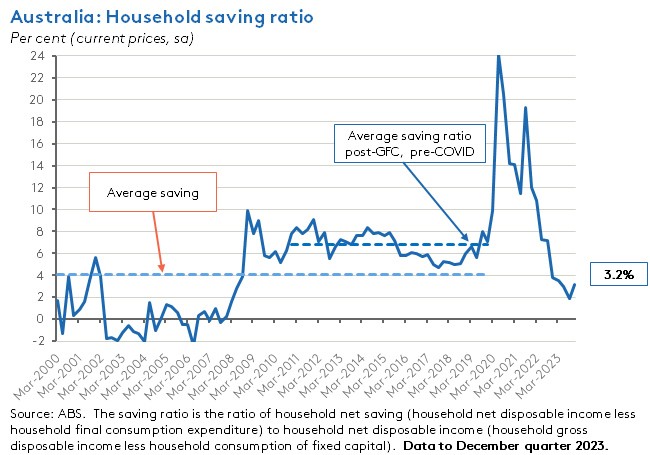
There was one piece of brighter news for households, as after eight consecutive quarterly falls, the household saving ratio rose to 3.2 per cent in the December quarter 2023. That was because income received by households exceeded income paid over the quarter. The ABS pointed to higher compensation of employees and government payments associated with increased benefit payments including JobSeeker and Commonwealth Rent assistance as driving the former, while the fall in income paid reflected lower income tax payments. That in turn was due to a partial retreat from the previous quarter’s sharp rise, with the Bureau highlighting changes across the past two quarters in terms of the timing of final tax return submissions.
The pace of inventory decline also accelerated last quarter with inventories falling $2.7 billion after declining by $0.6 billion in the September quarter 2023. The ABS noted that as imports of consumption goods had fallen, many wholesale and retail businesses had depleted their existing inventory stock to meet consumer demand. Mining inventories were also down as businesses met strong overseas demand for iron ore and coal. (Recall that for the change in GDP it is the change in net inventory investment that matters, where inventory investment is the change in the stock of inventory. That means that a larger decline in the current period than in the preceding period drives a decline in GDP.)
Living standards fall again as Australia’s ‘per capita recession’ continues
The final quarter of 2023 saw GDP per capita shrink for a third consecutive quarter (or for a fourth if one were to consider otherwise flat quarterly growth in the March quarter 2023 to three decimal places), dropping by 0.3 per cent relative to Q3:2023. Output per head also fell over the year, falling by one per cent. Australia remains stuck in a ‘per capita’ recession.
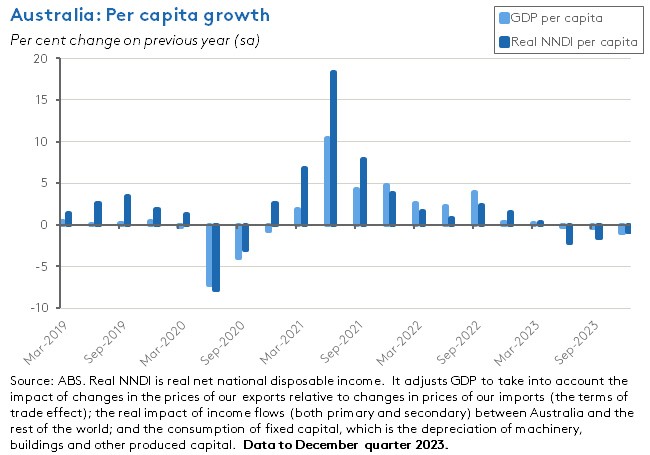
Real GDP per capita is often taken as a basic measure of the standard of living, so on this basis, living standards went backwards for pretty much the whole of last year. An alternative, broader measure of living standards is real net national disposable income per capita (Real NNDI) which also considers the impact of changes in the terms of trade, net income payable overseas and capital depreciation. Living standards on this basis also declined (again) last quarter.
Nominal developments consistent with easing price pressures
In nominal terms, GDP rose 1.4 per cent over the December quarter 2023 to be up 4.4 per cent over the year. The GDP implicit price deflator rose 1.2 per cent in quarterly terms, in part reflecting a 2.2 per cent rise in the terms of trade (although the latter were 3.9 per cent lower relative to the December quarter 2022).
In a sign of moderating domestic price pressures, the quarterly rate of growth in the domestic demand implicit price deflator eased to one per cent, down from consecutive 1.2 per cent increases in the previous two quarters. That was the lowest rate of increase since the December quarter 2021. In annual terms, the same deflator was still up a relatively strong 4.6 per cent, but again this was down from 5.2 per cent in the September quarter and a peak of 7.3 per cent in the final quarter of 2022.
Mixed news on productivity and unit labour costs
There was some positive news on labour productivity (measured as GDP per hour worked) which rose for a second consecutive quarter in the December quarter 2023 to be up 0.5 per cent over the September quarter. Even so, it was still down 0.4 per cent relative to the corresponding quarter in the year before.
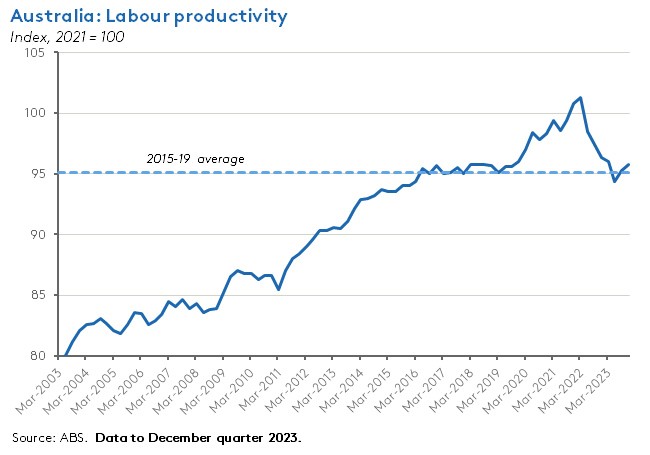
On the other hand, the gap between wage growth and productivity growth remained significant, such that growth in unit labour costs stayed elevated.
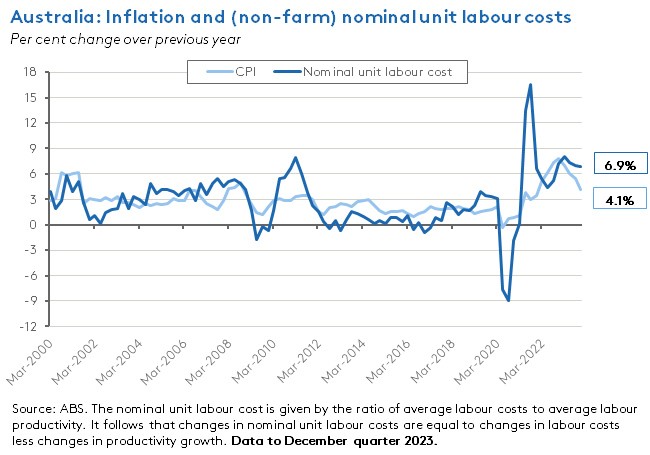
The RBA has indicated that for inflation to sustainably return to target over time, growth in labour costs and productivity growth will need to come into much closer alignment with each other.
What else happened on the Australian data front this week?
The ABS reported that Australia ran a current account surplus of $11.8 billion in the December quarter 2023 (seasonally adjusted). That was up more than $10.5 billion from the September quarter’s $1.3 billion surplus (itself revised up from the original estimates of a very small deficit). The large increase in the surplus reflected a large rebound in the size of Australia’s trade surplus and a smaller but still significant decline in the net primary income deficit. The balance on goods and services trade strengthened by $8.2 billion to reach $32.4 billion, powered by a 3.1 per cent increase in exports that was led by coal and metal ores (up in price and volume terms). There was also some modest growth for services exports. Meanwhile, imports of goods and services fell 2.6 per cent. The Bureau noted that imports of travel services fell for the first time in 2023 as Australians spent less travelling overseas, while the fall in goods imports was driven by a drop in imports of passenger vehicles. At the same time, the primary income deficit narrowed by $1.9 billion, falling to its smallest gap since the September quarter 2021. According to the ABS, this was driven by reduced profits on foreign direct investment leading to a drop in primary income debits.
Australia’s seasonally adjusted trade balance on goods rose by $284 million in January 2024 to a surplus of just over $11 billion. The ABS said exports were up 1.6 per cent over the month, driven by non-monetary gold, while imports rose 1.3 per cent, due to purchases of non-industrial transport equipment.
The general government net operating balance rose $12 billion from the September quarter 2023 to $2.2 billion in the December quarter 2023 (original basis). The ABS said total general government revenue rose 8.7 per cent over the quarter, lifted by a 13.1 per cent increase in tax revenue. Total general government expenses rose by 3.1 per cent.
The ABS Monthly Household Spending Indicator showed household spending rose three per cent over the year in January 2024 (current price, calendar adjusted basis). Spending was up for both goods (1.1 per cent) and services (4.9 per cent) and for discretionary (0.2 per cent) and non-discretionary (5.6 per cent) items. That annual rise of three per cent was the largest increase since September 2023 and was powered by increased spending on essential items including transport, food, and health.
ANZ-Indeed Australian Job Ads fell 2.8 per cent over the month in February 2024. That followed a significant upwardly revised monthly growth rate in January 2024 of 3.4 per cent (up from 1.7 per cent previously). The Job Ads Index has now fallen nearly 17 per cent from its November 2022 peak, although the series is still almost 38 per cent higher than pre-pandemic levels. ANZ noted that the fall in Job Ads follows January’s weaker-than-expected labour force results, which showed unemployment rising to 4.1 per cent and hours worked dropping 2.5 per cent over the month.
The ANZ-Roy Morgan Weekly Consumer Confidence Index fell 2.2 points to an index reading of 81 for the week ending 3 March 2024. That was the weakest reading of the year to date and the lowest since early December last year. All five subindices registered declines led by a 3.9 point drop in ‘Current financial conditions.’ ANZ reported that confidence among those paying off their homes continues to trend upwards, while confidence among renters and outright homeowners is down. At the same time, weekly inflation expectations fell 0.2 percentage points to 4.9 per cent. That’s the equal lowest inflation expectations reading since early February 2022 (along with readings in September last year and (twice) in February this year).
The ABS December quarter 2023 Business Indicators release shows company gross operating profits rose a strong 7.4 per cent over the quarter (seasonally adjusted) but were down 5.4 per cent in annual terms. In contrast, wages and salaries were almost flat over the quarter (up just 0.9 per cent) but rose eight per cent relative to the December quarter 2022.
In January this year, new loan commitments for housing fell 3.9 per cent over the month (seasonally adjusted) but were up 8.5 per cent year-on-year. The ABS said lending for owner occupiers was down 4.6 per cent month-on-month but up 3.4 per cent year-on-year, while lending to investors fell 2.6 per cent in monthly terms, while rising 18.5 per cent over the year. The number of refinanced owner-occupier home loans fell 7.6 per cent and was 30.8 per cent lower than in January 2023.
The ABS said total dwellings approved in January 2024 fell one per cent over the month (seasonally adjusted) to 12,850, although that was still 4.8 per cent higher than approvals in the same month last year. Approvals for private sector houses were down 9.9 per cent month-on-month and down 4.7 per cent year-on-year, while approvals for private sector dwellings excluding houses were up 19.5 per cent month-on-month and 22.6 per cent higher year-on-year, boosted by a rise in apartment approvals in Queensland. According to the Bureau, national approvals for private sector houses have now fallen for four consecutive quarters.
Last Friday, CoreLogic reported that its national Home Value Index (HVI) rose 0.6 per cent over the month in February 2024 to be 8.9 per cent higher over the year. The rate of monthly increase was up from 0.4 per cent in January and the strongest recorded since last October. All capital cities except for Hobart recorded increases in values, with the combined capitals index up 0.6 per cent over the month and 10 per cent over the year. The pickup in value growth also came alongside a bounce back in auction clearance rates. CoreLogic said the continued rise in home values ‘reflects a persistent imbalance between supply and demand which varies in magnitude across our cities and regions’. It also referenced a possible boost to housing confidence as inflation eases and expectations build for a rate cut(s) later this year. Pushing in the other direction, the data provider also highlighted affordability constraints, rising unemployment, a slowdown in the rate of household saving and a cautious lending environment. Growth in rental values has also re-accelerated, with the monthly growth rising to 0.9 per cent in February – the fastest rate of increase recorded since May 2023.
Other things to note . . .
- The ABS lists 11 things that happened in the Australian economy during the December quarter 2023.
- The Treasurer’s reaction to the December quarter 2023 National Accounts.
- Ahead of this week’s GDP numbers, Peter Martin argued Australia was already in an unofficial recession.
- Deloitte Access Economics reckons that although 2023 was the worst year for retail sales growth in a generation, Australia’s retail recession is finally over.
- From the Productivity Commission, the Annual Productivity Bulletin 2024. The Commission highlights that labour productivity for the whole economy fell by 3.7 per cent in 2022-23, as output growth failed to keep pace with a record increase in hours worked. The latter also led to an historical decline in the capital-labour ratio, which the Commission emphasised was a significant headwind for productivity. That economy-wide fall in productivity in 2022-23 returned the level of labour productivity to about the same as it was pre-pandemic, consistent with the ‘pandemic productivity bubble’ story we’ve highlighted before. In the market sector, labour productivity fell 2.9 per cent and multifactor productivity dropped 0.5 per cent. More than half the fall in market sector labour productivity was driven by the wholesale trade and accommodation and food services industries. The Bulletin also includes an update on wage decoupling (when growth in labour productivity exceeds growth in producer wages) which it finds increased over 2022-23 as real producer wages fell by more than productivity growth.
- The ACCC’s Issues Paper for its Supermarkets Inquiry 2024-25.
- The final report from the Senate Community Affairs References Committee on the extent and nature of poverty in Australia.
- Jobs and Skills Australia released its first Labour Market Update for 2024.
- The Grattan Institute defends the government’s ‘Help to Buy’ scheme and also offers supportive thoughts on the proposed New Vehicle Efficiency Standard, albeit with some qualifications around the nature of the targets set.
- The AFR’s Chanticleer column reckons China’s five per cent growth target for this year is unrealistic for six reasons: Unsustainable debt in China’s local government and property sectors; the onset of deflation raising the risk of a liquidity trap; adverse demographics; a loss of confidence in leadership; too much centralisation of power and the possibility of a Trump election win later this year leading to new tariffs on Chinese goods.
- The BIS March 2024 Quarterly Review includes a special feature on the natural rate of interest after the pandemic.
- Torsten Slok explains why he thinks the Fed won’t cut rates in 2024.
- An IMF Working Paper looks at the US banking sector in the aftermath of the March 2023 crises. (See also the Odd Lots podcast linked below.)
- Two interesting pieces from the WSJ. The first warns the world economy is facing another ‘China shock’, as Beijing is relying on exports of cars, machinery and consumer electronics to boost economic growth. But in a significant difference from the previous ‘China shock’ of the early 2000s, the piece argues, this time the disinflationary impact of cheap Chinese manufactured goods won’t be offset by soaring Chinese demand for commodities, given that overall Chinese economic growth is slowing. A second difference is that China is now competing more directly with advanced economies in sectors such as cars, computer chips and complex machinery, leading to rising trade tensions. The second piece reckons rich countries are becoming addicted to cheap labour as businesses rely more on migrant workers to offset domestic labour shortages. Immigration is now running at two-to-three times above pre-pandemic levels in a range of advanced economies, including the United States, Canada, Germany and the UK. But some economists argue that increased reliance on low skill imported labour can lead to weaker overall productivity growth, by discouraging the search for alternatives in the form of automation or by allowing low productivity businesses to continue to operate.
- Introducing a framework for geoeconomics.
- The Economist magazine considers Africa in a multipolar world.
- Attempting to assess the medium-term macroeconomic effects of Russia’s war in Ukraine.
- Bruegel analyses the state of the EU-Russia energy divorce.
- The OECD has opened accession negotiations with Indonesia.
- The FT’s Martin Sandbu on America’s productivity boom.
- Understanding hunter-gatherers.
- The Odd Lots podcast talks to Anat Admati on US banks and banking regulation after the collapse of Silicon Vally Bank in March 2023.
- The FT’s Unhedged podcast asks, is ESG over?
Latest news
Already a member?
Login to view this content



